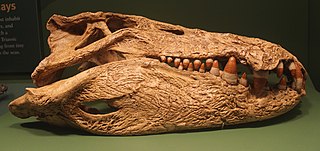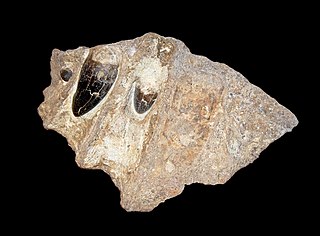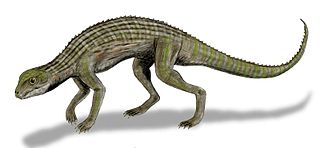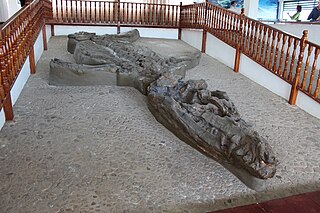
Mahajangasuchus is an extinct genus of crocodyliform which had blunt, conical teeth. The type species, M. insignis, lived during the Late Cretaceous; its fossils have been found in the Maevarano Formation in northern Madagascar. It was a fairly large predator, measuring up to 4 metres (13 ft) long.

Anatosuchus is an extinct genus of notosuchian crocodylomorph discovered in Gadoufaoua, Niger, and described by a team of palaeontologists led by the American Paul Sereno in 2003, in the Journal of Vertebrate Paleontology. Its duck-like snout coincidentally makes it resemble a crocoduck, an imagined hybrid animal with the head of a crocodile and the body of a duck.

Razanandrongobe is a genus of carnivorous ziphosuchian crocodyliform from the Middle Jurassic of Madagascar. It contains the type and only species Razanandrongobe sakalavae, named in 2004 by Simone Maganuco and colleagues based on isolated bones found in 2003. The remains, which included a fragment of maxilla and teeth, originated from the Bathonian-aged Sakaraha Formation of Mahajanga, Madagascar. While they clearly belonged to a member of the Archosauria, Maganuco and colleagues refrained from assigning the genus to a specific group because the fragmentary remains resembled lineages among both the theropod dinosaurs and crocodylomorphs.

Baurusuchus is an extinct genus of baurusuchid mesoeucrocodylian, which lived in Brazil from 90 to 83.5 million years ago, in the Late Cretaceous period. It was a terrestrial predator and scavenger, estimated to reach up to 113.4 kilograms (250 lb) in weight. Baurusuchus lived during the Turonian to Santonian stages of the Late Cretaceous Period, in Adamantina Formation, Brazil. It gets its name from the Brazilian Bauru Group. It was related to the earlier-named Cynodontosuchus rothi, which was smaller, with weaker dentition. The three species are B. pachechoi, named after Eng Joviano Pacheco, its discoverer, B. salgadoensis and B. albertoi. The latter species is disputed. Its relatives include the similarly sized Stratiotosuchus from the Adamantina Formation, and Pabweshi, from the Pakistani Pab Formation.

Adamantinasuchus is an extinct genus of notosuchian crocodylomorph from and named after the Late Cretaceous Adamantina Formation of Brazil. It is known from only one fossil, holotype UFRJ-DG 107-R, collected by William Nava. The fossil consists of a partial skull, fragmentary limb bones and a few broken vertebrae, and was found 25 kilometres (16 mi) southwest of the town of Marilia, near a reservoir dam. Adamantinasuchus was approximately 60 centimetres (24 in) long from nose to tail, and would have only weighed a few kilograms.

Baurusuchidae is a Gondwanan family of mesoeucrocodylians that lived during the Late Cretaceous. It is a group of terrestrial hypercarnivorous crocodilians from South America and possibly Pakistan. Baurusuchidae has been, in accordance with the PhyloCode, officially defined as the least inclusive clade containing Cynodontosuchus rothi, Pissarrachampsa sera, and Baurusuchus pachecoi. Baurusuchids have been placed in the suborder Baurusuchia, and two subfamilies have been proposed: Baurusuchinae and Pissarrachampsinae.

Sphagesaurus is an extinct genus of sphagesaurid notosuchian crocodylomorph from the Late Cretaceous of southwest São Paulo, southern Brazil.
Pabwehshi is an extinct genus of mesoeucrocodylian. It is based on GSP-UM 2000, a partial snout and corresponding lower jaw elements, with another snout assigned to it. These specimens were found in Maastrichtian-age Upper Cretaceous rocks of the Vitakri and Pab Formations in Balochistan, Pakistan, and represent the first diagnostic crocodyliform fossils from Cretaceous rocks of South Asia. Pabwehshi had serrated interlocking teeth in its snout that formed a "zig-zag" cutting edge. Pabwehshi was named in 2001 by Jeffrey A. Wilson and colleagues. The type species is P. pakistanensis, in reference to the nation where it was found. It was traditionally classified as a baurusuchid closely related to Cynodontosuchus and Baurusuchus. Larsson and Sues (2007) found close affinity between Pabwehshi and the Peirosauridae within Sebecia. Montefeltro et al.Pabwehshi has a sagittal torus on its maxillary palatal shelves – a character that is absent in baurusuchids – but they did not include Pabwehshi in their phylogenetic analysis.

Armadillosuchus is an extinct genus of sphagesaurid crocodylomorph. It was described in February 2009 from the late Campanian to early Maastrichtian Adamantina Formation of the Bauru Basin in Brazil, dating to approximately 70 Ma. Armadillosuchus was among the larger and more robust sphagesaurids, with a total length of approximately 2 metres (6.6 ft).

Polonosuchus is a genus of rauisuchid known from the late Triassic of Poland. It was a huge predator about 5–6 metres in length and, like all rauisuchians, was equipped with a large head of long sharp teeth. The legs were placed almost underneath the body, unlike most reptiles, which would have made it quite fast and a powerful runner. The appearance was very similar to that of the more known Postosuchus, of North America, and shared with the latter the ecological niche of the apex predator.

Peirosaurus is an extinct genus of peirosaurid crocodylomorph known from the Late Cretaceous period of Minas Gerais, southern Brazil. It contains a single species, Peirosaurus torminni. It is the type genus of the family Peirosauridae.

Stratiotosuchus is an extinct genus of baurusuchid mesoeucrocodylian from the Adamantina Formation in Brazil. It lived during the Late Cretaceous. The first fossils were found in the 1980s, and the type species Stratiotosuchus maxhechti was named in 2001. A hyperpredator, it and other baurusuchids may have filled niches occupied elsewhere by theropod dinosaurs.

Campinasuchus is an extinct genus of baurusuchid mesoeucrocodylian from Minas Gerais State of Brazil.

Pissarrachampsa is an extinct genus of baurusuchid mesoeucrocodylian from the Late Cretaceous of Brazil. It is based on a nearly complete skull and a referred partial skull and lower jaw from the ?Campanian - ?Maastrichtian-age Vale do Rio do Peixe Formation of the Bauru Group, found in the vicinity of Gurinhatã, Brazil.

Pissarrachampsinae is a subfamily of baurusuchid crocodyliforms from the Late Cretaceous of Brazil and Argentina. It was named in 2011 with the description of Pissarrachampsa sera and includes P. sera from Brazil and the related Wargosuchus australis from Argentina. Pissarrachampsinae is one of two subfamilies of Baurusuchidae, the other being Baurusuchinae.

Baurusuchinae is a subfamily of baurusuchid crocodyliforms from the Late Cretaceous of Brazil. Named in 2011, it contains the baurusuchids Aphaurosuchus, Aplestosuchus, Baurusuchus and Stratiotosuchus. Baurusuchinae is one of two subfamilies of Baurusuchidae, the other being Pissarrachampsinae.

Caipirasuchus is an extinct genus of sphagesaurid notosuchians known from the Late Cretaceous of northern São Paulo State, southeastern Brazil. The type species, C. paulistanus, was named in 2011. A second species, C. montealtensis, was referred to Caipirasuchus in 2013 after having been named in 2008 as a species of Sphagesaurus. A third species, C. stenognathus, was described in 2014. A fourth species, C. mineirus, was described in 2018. A fifth species, C. attenboroughi, was named in 2021 in honour of David Attenborough.

Aplestosuchus is an extinct genus of baurusuchid mesoeucrocodylian known from the Late Cretaceous Adamantina Formation of São Paulo, southern Brazil. It contains a single species, Aplestosuchus sordidus. A. sordidus is represented by a single articulated and nearly complete skeleton, preserving the remains of an unidentified sphagesaurid crocodyliform in its abdominal cavity. The specimen represents direct evidence of predation between different taxa of crocodyliforms in the fossil record.

Monquirasaurus is an extinct genus of giant short-necked pliosaurs who lived during the Early Cretaceous (Aptian) in what is now Colombia. One species is known, M. boyacensis, described in 2021 from an almost complete fossil skeleton, discovered in 1977 in the town of Villa de Leyva, located in Boyacá. Published descriptions of the holotype specimen estimate that it should reach a total size approaching 8 m (26 ft) in length, making Monquirasaurus a large representative of the pliosaurids.
Titanochampsa is a genus of large mesoeucrocodylian from the Maastrichtian Marilia Formation of Brazil. Although only known from a single skull roof, the material shows that Titanochampsa was not a member of Notosuchia, which were previously believed to have been the only crocodyliforms present in the strata of the Bauru Group. Body size estimates vary greatly and range between 2.98–5.88 m due to the incomplete nature of the holotype fossil. The overall anatomy of the skull roof, alongside its size and possible affinities with Neosuchians, may suggest that it was a semi-aquatic ambush hunter similar to modern crocodilians.















